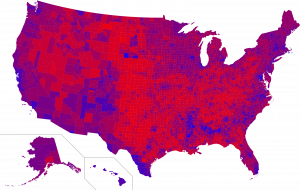34 North America: Political Geography I – Political-Ideological Regions

In the 2016 presidential election, the votes in Claiborne County and Wayne County were not at all close. In Claiborne County, 87% of voters selected Hillary Clinton. In Wayne County, 84% of voters chose Donald Trump. This might not surprise many people, given the apparent polarization of the American political map. What might surprise them, however, is the location of those two counties. The heavily Republican Wayne County is in Illinois. The heavily Democratic Claiborne County is in Mississippi.
Each presidential election generates a new map. States won by the Democratic candidate are shaded blue, and states won by the Republican candidate are shaded red. For the past several elections, many of those states have always been solid blue, while others remain solid red. These maps are useful, given the winner-take-all nature of the electoral college, but they can create something of a political mirage. These maps might leave someone with the impression that nearly everyone in Texas, Georgia, and Missouri is a Republican, while nearly everyone in California, New York, and Illinois is a Democrat. That is not the case. In 2016, Hillary Clinton received a significant share of the vote in Texas (43%), Georgia (46%), and Missouri (38%), while Donald Trump received a significant share of the vote in California (32%), New York (37%), and Illinois (39%). While none of these states were terribly competitive, it is important to note that there are plenty of Democrats in red states, and plenty of Republicans in blue states. It is rare for the losing presidential candidate in a state to receive less than a third of the vote.

That said, there are certainly areas of the country that tend to lean heavily toward one party or the other, while other parts of the country are extremely competitive. Here, we will look at nine essential facts about America’s political-ideological geography. We will examine the places where Democrats or Republicans do well in elections, as well as those places that are competitive. The first three facts will include brief examinations of the traditionalistic, moralistic, and individualistic American political subcultures, which were first defined by political scientist Daniel J. Elazar in 1966.
- Republicans Do Well in the Traditionalistic South.
The Southern political region roughly corresponds to those states that were once part of the Confederacy: South Carolina, Mississippi, Alabama, Georgia, Louisiana, Texas, Virginia, Arkansas, Tennessee, and North Carolina. The region also includes West Virginia, Kentucky, Oklahoma, and southern Missouri, which were not part of the Confederacy, but which have traditionally shared the South’s political ideology. Florida was part of the Confederacy, but is its own unique political region, and will be discussed below.
The South is the birthplace of the traditionalistic American political subculture, and is still dominated by it. This subculture is built on three foundational beliefs. First, respect for traditional religious, family, and social values are profoundly important, and politicians are expected to share those values. Second, government should be small and limited to basic operations; it should not be expansive or innovative. Third, taxation and spending should, as a result, be limited.
The South was once solidly Democratic, but the political emphasis on small government, low taxes, and traditional values much more closely aligns with the Republican Party today. For the last forty years, the South has been solidly red. As we’ll see below, Virginia has drifted somewhat from these traditionalist values, as has North Carolina. There are even signs that Texas and Georgia are shifting from the traditionalist subculture, and could turn blue in the next decade or so. The rest of the South, however, shows few signs of abandoning their loyalty to the Republican Party anytime soon.
- Democrats Do Well in Moralistic New England and the West Coast.
New England was the birthplace of the moralistic political subculture. This subculture is the polar opposite of the traditionalistic subculture. It believes that government can and should be a positive agent promoting the collective well-being, and that politicians should be driven by progressive issues. Government should not be limited, but large and innovative, and taxation and spending should be utilized to promote the public good.
These ideals closely align with the liberal wing of the Democratic Party. New England was, for many years, a Republican stronghold. The abolitionist movement was born in New England, and drove the early evolution of the Republican Party. Over time, however, as Republicans grew more conservative, the region began to drift away from the party, and is now mostly Democratic. Two standard-bearers of the moralistic subculture, Senators Bernie Sanders and Elizabeth Warren, are from Vermont and Massachusetts, respectively. In 2016, Donald Trump did not win a single county in either of those states.
The moralistic subculture is also strong on the West Coast, particularly in liberal bastions like San Francisco, Portland, and Seattle. This region was the political hearth of a number of progressive ideals, including the gay rights and environmentalist movements. Democrats usually dominate statewide races in California, Oregon, and Washington.
- Much of the Individualistic Midwest is Competitive.
North Dakota, South Dakota, Nebraska, Kansas, and Missouri all have a tendency to lean Republican in presidential elections, but each of those states has elected a Democratic governor or U.S. senator at some point in the last two decades. Minnesota and Illinois tend to lean Democratic in presidential elections, but both states have elected Republican senators and governors over the last two decades.
The rest of the Midwest – Iowa, Wisconsin, Michigan, Indiana, and Ohio – along with neighboring Pennsylvania, are some of the most competitive states in presidential elections. They are classic swing states. They are dominated by the individualistic political subculture, which originated among German and English settlers in the Mid-Atlantic states. They carried their ideals across the Appalachians to the Midwest, where the subculture is strongest today. The individualistic subculture falls between the moralistic and traditionalistic subcultures, both geographically and ideologically. Unlike traditionalistic Southerners, Midwesterners are not obsessed with making government as small possible. They typically favor good schools, a solid infrastructure, safe streets, and a strong military, and they are willing to pay taxes to maintain them. That said, Midwesterners often find that the moralistic subculture of New England and the West Coast takes things too far. Individualistic voters don’t believe that government is a bad thing, but also don’t believe that it’s government’s job to solve all of the world’s problems.
Essentially, individualistic voters view government as a business. It should be practical and utilitarian. Taxes are an investment, and voters expect a return on that investment. Government spending should emphasize economic growth. Voters in this subculture are generally unconcerned with a candidate’s personal life – they’re not expecting politicians to be saints or crusaders, they simply want pragmatism. Extremely liberal or extremely conservative ideologues have a tough time in the Midwest’s swing states. Voters there have demonstrated that they are willing to swing from one party to the other, provided the candidate is moderate and practical.
- Hybrid Florida is Very Competitive.
Florida is an unusual mixture of voters. The northern part of the state is an extension of the South’s traditionalistic region, which heavily favors Republicans. Florida is a popular destination for retirees, most of whom are older, white, and middle or upper-class, which also favors Republicans. However, Florida is also home to numerous large cities and a significant immigrant population, which strongly favors Democrats. Additionally, much of the state has been settled by migrants from the individualistic Midwest and Mid-Atlantic, who might favor moderates of either party. As a result, margins between Republicans and Democrats tend to be razor thin in Florida. That fact, coupled with the state’s large allotment of electoral votes, makes it one of the most hotly contested states in each presidential election.
- Republicans Do Better with White Voters; Democrats Do Better with Voters of Color.
According to exit polls in 2016, Donald Trump won 58% of the white vote, compared to Hillary Clinton’s 37%, a huge margin. Clinton, however, did far better among the three primary non-white populations, trouncing Trump among Black voters (88% to 8%), Latinx voters (66% to 28%), and Asian voters (79% to 17%).
These numbers do not bode well for Republicans. The percentage of non-white voters in the United States is steadily increasing, and it stands to shift the political map significantly if party loyalties remain the same. Nowhere is this more apparent than the Interior West. The region has traditionally been a Republican stronghold, and some of Trump’s biggest margins of victory came in states like Wyoming, Idaho, Montana, and Utah – he won each of those states by more than ten percentage points. They are also predominantly white. 78% of Utah’s population is white, and in Wyoming, Idaho, and Montana, that number tops 80%. Hillary Clinton, however, won states where the white population was smaller, including Colorado (68% white), Nevada (48% white), and New Mexico (37% white). Trump won by just four points in Arizona, which is 54% white. Arizona, usually solid red, might turn blue in 2020.
- College-Educated Voters are Trending Democratic.
For years, the Republican Party’s policies have favored business owners and managers, while the Democrats were largely the party of the working class. As a result, Republicans have traditionally fared better among voters with a college degree. That pattern has been reversing for several years, and in 2016, Hillary Clinton defeated Donald Trump among college-educated voters, 52% to 43%. This trend explains North Carolina’s shift from a solid-red state to a swing state. As cities like Charlotte and Raleigh-Durham have morphed into major centers of finance and research, North Carolina has experienced a significant increase in the number of voters who are college graduates.
This trend was also reflected in 2016’s national electoral map. The ten states with the highest percentage of college graduates are Massachusetts, Colorado, Maryland, Connecticut, New Jersey, Virginia, Vermont, New Hampshire, New York, and Minnesota. All ten of those states were won by Hillary Clinton. The ten states with the lowest percentage of college graduates are Mississippi, Arkansas, Kentucky, Louisiana, Nevada, Alabama, Oklahoma, Indiana, Tennessee, and Wyoming. All but one of those states were won by Donald Trump.
- Democrats Do Well in Cities
Cities are big, complex places, often requiring big, complex government programs. Compared to rural areas and small towns, cities also tend to be younger, more ethnically diverse, and better educated. Urban populations tend to be progressive on social and cultural issues, like race, gender, and sexuality. City dwellers are also likely to recognize the societal codependence required of living in a densely populated area. All of these traits strongly favor Democrats. This is why Democrats usually do well in places like the Northeast, the West Coast, and the Steel Belt, all home to large urban agglomerations.
State by state, large and mid-sized urban areas tend to be blue. In 2016, Hillary Clinton won in just twelve of Illinois’ 102 counties, but they were all densely populated counties, allowing her to carry the state comfortably: Six of them were in the Chicago metro area, one was in the St. Louis metro area, and the remaining five contained the mid-sized cities of Champaign-Urbana, Carbondale, Peoria, Moline, and Rockford. Cities lean Democratic even in deep-red states. In Utah, which was easily won by Donald Trump, Clinton still won in Salt Lake County, home of the state’s largest city.
- Republicans Do Well in Rural Areas
Democrats do well in some rural areas. Claiborne County, Mississippi, mentioned at the top of this chapter, is a very rural area of only about 9,600 people. In 2016, Hillary Clinton received 87% of the votes in Claiborne County, which is, not coincidentally, 84% African-American. Similarly, Zapata County, Texas, home to just 14,000 people, delivered 66% of the vote to Hillary Clinton. Zapata County is 85% Latinx.
Most rural counties in the United States, however, are predominantly white, and lean heavily Republican. Wayne County, Illinois, where Donald Trump received 84% of the vote, is 98% white. As mentioned above, Wayne is one of the ninety Illinois counties, mainly rural and white, won by Trump. In deep-blue California, Donald Trump failed to receive even a third of the statewide vote, but cruised with 72% of the vote in Lassen County, which is located in the remote, rural northeastern corner of the state.
In addition to being whiter than the national average, rural areas also tend to be older and have a lower percentage of college graduates. They also tend to adhere to traditional views of cultural, religious, and social issues, all of which favor Republicans. Unlike big and complex cities that highlight societal codependence, life in rural areas often features a good deal of personal independence. State and federal governments are often seen as a distant nuisance, at best. Many rural voters prefer that problems be solved by families, churches, or local government. This also very much favors Republicans.
- The Suburbs are Increasingly Competitive
Like North Carolina, Virginia used to be a solidly conservative, but it has drifted toward the political center in recent years. It now leans Democratic in presidential elections, and a major part of that shift has come from northern Virginia, in the suburbs of Washington, D.C.
The suburbs have traditionally been white and middle or upper-class. As a result, they have also traditionally been predominantly Republican. That is changing. Suburban Republicans often do not share some of the deeply conservative values of rural Republicans. On cultural, environmental, and social issues, as well as on the issue of immigration, suburban voters tend to be relatively moderate. The suburbs are also becoming more ethnically diverse. Most importantly, suburbs tend to have very high concentrations of college-educated voters. All of these trends favor Democrats. While suburban voters are unlikely to flock to extremely liberal candidates anytime soon, they are increasingly turned off by extremely conservative candidates as well. Donald Trump, in particular, has become deeply unpopular in the suburbs, particularly among college-educated women. In 2016, Donald Trump won the suburban vote, 49% to 45%. Polls in mid-2020 have him losing 60% to 35%, a massive collapse. Suburban counties will be among the most closely watched in the 2020 election.
10 – America as a Republic?
America seems more polarized than ever. Occasionally, pundits suggest breaking up the United States into relatively uniform political regions. How might this work? The map below suggests that America be divided into eight regions. Each region would be a piece in the American Federation, able to create its own laws, yet belonging together for necessities like national defense.
This map is based on the county voting patterns of the 2020 presidential election. The map also features the rule of contiguity. Counties in each republic must connect to an adjacent county in the same republic. In a few cases counties are flipped in order to maintain contiguity; for instance, a county voting Democratic may be flipped to a Republican region in order to connect other Republican counties. On the map, the three Republican regions are shaded dark red, red, or orange.
Did You Know?
Missouri, now a reliably red state, was once the ultimate swing state. In the 20th Century, Missouri voted for the winner in all but one presidential election. In 1956, Missouri was won by Illinois Governor Adlai Stevenson, who lost the general election to President Dwight D. Eisenhower.
Cited and additional bibliography:
Quam, Joel. Map. American Republic. 2023.
Zifan, Ali. 2017. “2016 Presidential Election by County (Red-Blue-Purple_View).” https://commons.wikimedia.org/wiki/File:2016_Presidential_Election_by_County_(Red-Blue-Purple_View).svg. Creative Commons Attribution-Share Alike 4.0 International .






